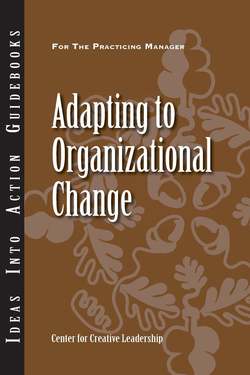Читать книгу Adapting to Organizational Change - David Dinwoodie - Страница 8
На сайте Литреса книга снята с продажи.
ОглавлениеChange and Transition
Today there seems to be very little business as usual. Turbulence is common, with organizations facing a dizzying array of changes. Many of these are small, but a significant number affect the entire organization. An organization’s mission may change, as well as its focus, strategy, culture, and market. Such changes can have a serious impact on you as a leader.
Your success as a leader will very likely depend on how well you deal with such change. Research by the Center for Creative Leadership has found that successful executives adapt to the changing external pressures facing the organization, adjust management style to changing situations, accept changes as positive, revise plans as necessary, and take into account people’s concerns during change. In fact, in CCL’s research regarding North American and European leaders, the most frequently mentioned success factor was the ability to adapt. In describing leaders they knew, American leaders mentioned adaptability in 55 percent of the success stories that they shared, and European leaders mentioned adaptability in 67 percent of the success stories that they shared.
CCL research has also found that leaders who aren’t able to adapt to change—those who show a marked resistance to change and an inability to learn from feedback and be flexible—are likely to derail: to stop advancing or even leave the organization.
But what do you need to do in order to adapt?
First, it is imperative that you clearly understand the difference between change and transition during times of organizational turbulence. As a leader, you will be expected not only to contend with destabilizing events within the organization but also to adjust your management style to deal with the reactions that accompany change.
Change can best be understood as the situations and occurrences that impact organizations and individuals—such as a new boss, a move to another physical location, or a shift in policy. Change typically happens quickly and most often begins with the realization that something new has begun. It creates the need to move from “the way it used to be” to “the way it is now.”
Unlike change, transition is best understood as the internal psychological process of adapting to a new situation. Transition can happen quickly or slowly and is marked not by a new beginning but by the end of a previous condition. It is the process of moving successfully from the old to the new. Furthermore, change and transition often occur at the same time, which makes the ability to recognize them even more important.
Once you understand the difference between change and transition, you can take the second step: identify how the changes in the organization affect your feelings and thoughts, and focus on managing the transition. Becoming aware of these thoughts and feelings is a key aspect of adapting to change.
According to CCL feedback coaches, leaders who have experienced significant changes within their organizations react with a similar set of thoughts and feelings—although, at the time, many do not recognize the connection between them. For many of these leaders, changes within and outside their organizations challenge their experience with being right and in control. If left unresolved, the resulting self-doubts and negativity can lead otherwise successful people to derail.
